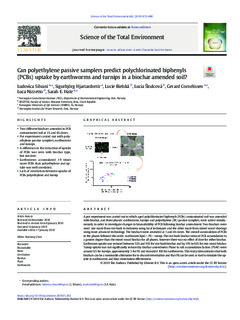| dc.contributor.author | Ludovica, Silvani | |
| dc.contributor.author | Sigurbjörg, Hjartardottir | |
| dc.contributor.author | Lucie, Bielská | |
| dc.contributor.author | Lucia, Škulcová | |
| dc.contributor.author | Gerard, Cornelissen | |
| dc.contributor.author | Luca, Nizzetto | |
| dc.contributor.author | Sarah E., Hale | |
| dc.date.accessioned | 2019-09-23T14:18:24Z | |
| dc.date.available | 2019-09-23T14:18:24Z | |
| dc.date.issued | 2019 | |
| dc.identifier.citation | Science of the Total Environment. 2019, 662, 873-880. | nb_NO |
| dc.identifier.issn | 0048-9697 | |
| dc.identifier.uri | http://hdl.handle.net/11250/2618302 | |
| dc.description.abstract | A pot experiment was carried out in which aged polychlorinated biphenyls (PCBs) contaminated soil was amended with biochar, and three phases: earthworms, turnips and polyethylene (PE) passive samplers, were added simultaneously in order to investigate changes in bioavailability of PCB following biochar amendment. Two biochars were used: one made from rice husk in Indonesia using local techniques and the other made from mixed wood shavings using more advanced technology. The biochars were amended at 1 and 4% doses. The overall accumulation of PCBs to the phases followed the order: earthworm lipid > PE > turnip. The rice husk biochar reduced PCB accumulation to a greater degree than the mixed wood biochar for all phases, however there was no effect of dose for either biochar. Earthworm uptake was reduced between 52% and 91% for rice husk biochar and by 19% to 63% for mix wood biochar. Turnip uptake was not significantly reduced by biochar amendment. Phase to soil accumulation factors (PSAF) were around 0.5 for turnips, approximately 5 for PE and exceeded 100 for earthworms. This study demonstrates that both biochars can be a sustainable alternative for in situ soil remediation and that PE can be used as tool to simulate the uptake in earthworms and thus remediation effectiveness. | nb_NO |
| dc.language.iso | eng | nb_NO |
| dc.publisher | Elsevier | nb_NO |
| dc.rights | Navngivelse 4.0 Internasjonal | * |
| dc.rights.uri | http://creativecommons.org/licenses/by/4.0/deed.no | * |
| dc.title | Can polyethylene passive samplers predict polychlorinated biphenyls (PCBs) uptake by earthworms and turnips in a biochar amended soil? | nb_NO |
| dc.type | Journal article | nb_NO |
| dc.type | Peer reviewed | nb_NO |
| dc.description.version | publishedVersion | nb_NO |
| dc.rights.holder | © 2019 The Authors | nb_NO |
| dc.source.pagenumber | 873-880 | nb_NO |
| dc.source.volume | 662 | nb_NO |
| dc.source.journal | Science of the Total Environment | nb_NO |
| dc.identifier.doi | 10.1016/j.scitotenv.2019.01.202 | |
| dc.identifier.cristin | 1663393 | |
| dc.relation.project | Norges forskningsråd: 243789 | nb_NO |

